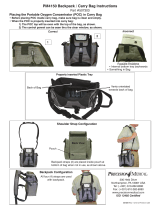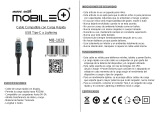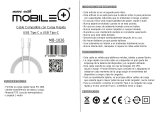
Original Instruction ManualPrinted on chlorine-free paper
Printing inks contain vegetable oils, paper can be recycled.
© ANDREAS STIHL AG & Co. KG 2019
0458-794-8621-C. VA8.D19.
0000007681_007_GB
0458-794-8621-C
English
1
This instruction manual is protected by copyright. All rights reserved, especially the rights to reproduce, translate and process
with electronic systems.
Contents
1 Introduction
. . . . . . . . . . . . . . . . . . . . . . . . . . . . . . . . . . . . . . . . .
2
2 Guide to Using this Manual
. . . . . . . . . . . . . . . . . . . . . . . . . .
2
2.1 Signal Words
. . . . . . . . . . . . . . . . . . . . . . . . . . . . . . . . . . . . . . . .
2
2.2 Symbols in Text
. . . . . . . . . . . . . . . . . . . . . . . . . . . . . . . . . . . . .
3
3 Main Parts
. . . . . . . . . . . . . . . . . . . . . . . . . . . . . . . . . . . . . . . . . .
3
3.1 Backpack Battery
. . . . . . . . . . . . . . . . . . . . . . . . . . . . . . . . . . .
3
4 Safety Symbols on the Product
. . . . . . . . . . . . . . . . . . . . . .
4
4.1 Backpack Battery
. . . . . . . . . . . . . . . . . . . . . . . . . . . . . . . . . . .
4
5 IMPORTANT SAFETY INSTRUCTIONS
. . . . . . . . . . . . .
5
5.1 Battery Warnings and Instructions
. . . . . . . . . . . . . . . . . . .
5
5.2 Operator
. . . . . . . . . . . . . . . . . . . . . . . . . . . . . . . . . . . . . . . . . . . .
6
5.3 Connecting Cord
. . . . . . . . . . . . . . . . . . . . . . . . . . . . . . . . . . . .
7
5.4 Using the Backpack Battery
. . . . . . . . . . . . . . . . . . . . . . . . .
7
6 Maintenance, Repair and Storage
. . . . . . . . . . . . . . . . . . .
9
6.1 Warnings and Instructions
. . . . . . . . . . . . . . . . . . . . . . . . . . .
9
7 Before Starting Work
. . . . . . . . . . . . . . . . . . . . . . . . . . . . . . .
10
7.1 Preparing the Backpack Battery for Operation
. . . . . .
10
8 Charging the Backpack Battery
. . . . . . . . . . . . . . . . . . . . .
10
8.1 Setting up the Charger
. . . . . . . . . . . . . . . . . . . . . . . . . . . . .
10
8.2 Charging
. . . . . . . . . . . . . . . . . . . . . . . . . . . . . . . . . . . . . . . . . . .
10
9 LED Diagnostics and Acoustic Signals
. . . . . . . . . . . . .
11
9.1 Battery Status
. . . . . . . . . . . . . . . . . . . . . . . . . . . . . . . . . . . . . .
11
9.2 Power Tool Status
. . . . . . . . . . . . . . . . . . . . . . . . . . . . . . . . . .
12
9.3 Charge Status
. . . . . . . . . . . . . . . . . . . . . . . . . . . . . . . . . . . . . .
12
10 Assembling the Backpack Battery
. . . . . . . . . . . . . . . . . .
12
10.1 Attaching the Connecting Cord
. . . . . . . . . . . . . . . . . . . . .
12
10.2 Attaching and Removing the Rain Cover
. . . . . . . . . . .
13
10.3 Attaching the Pouch
. . . . . . . . . . . . . . . . . . . . . . . . . . . . . . .
13
11 Adjusting the Backpack Battery
. . . . . . . . . . . . . . . . . . . . .
13
11.1 Positioning and Adjusting the Connecting Cord
. . . . .
13
11.2 Putting on the Harness
. . . . . . . . . . . . . . . . . . . . . . . . . . . . .
14
12 Connecting the Backpack Battery to the Power
Tool
. . . . . . . . . . . . . . . . . . . . . . . . . . . . . . . . . . . . . . . . . . . . . . . .
15
12.1 Connecting the Backpack Battery to a Power
Tool with an Integrated Socket
. . . . . . . . . . . . . . . . . . . . .
15
12.2 Connecting the Backpack Battery to a Power
Tool with a Battery Compartment
. . . . . . . . . . . . . . . . . . .
15
12.3 Disconnecting the Backpack Battery
. . . . . . . . . . . . . . .
16
13 After Finishing Work
. . . . . . . . . . . . . . . . . . . . . . . . . . . . . . .
16
13.1 Preparing for Transportation or Storage
. . . . . . . . . . . .
16
14 USB Port (AR 1000 only)
. . . . . . . . . . . . . . . . . . . . . . . . . . .
17
14.1 Charging a USB Device
. . . . . . . . . . . . . . . . . . . . . . . . . . . .
17
15 Transporting
. . . . . . . . . . . . . . . . . . . . . . . . . . . . . . . . . . . . . . .
17
15.1 Transporting the Backpack Battery
. . . . . . . . . . . . . . . . .
17
16 Storing
. . . . . . . . . . . . . . . . . . . . . . . . . . . . . . . . . . . . . . . . . . . . .
18
16.1 Storing the Backpack Battery
. . . . . . . . . . . . . . . . . . . . . .
18
17 Cleaning
. . . . . . . . . . . . . . . . . . . . . . . . . . . . . . . . . . . . . . . . . . .
18
17.1 Cleaning the Backpack Battery
. . . . . . . . . . . . . . . . . . . . .
18
17.2 Clean the Contact Surfaces of the Connecting
Cord
. . . . . . . . . . . . . . . . . . . . . . . . . . . . . . . . . . . . . . . . . . . . . . .
19
18 Inspection and Maintenance
. . . . . . . . . . . . . . . . . . . . . . .
19
18.1 Inspecting and Maintaining the Backpack Battery
. . .
19
19 Troubleshooting Guide
. . . . . . . . . . . . . . . . . . . . . . . . . . . . .
20
19.1 Backpack Battery
. . . . . . . . . . . . . . . . . . . . . . . . . . . . . . . . . .
20
20 Specifications
. . . . . . . . . . . . . . . . . . . . . . . . . . . . . . . . . . . . . .
22
20.1 STIHL AR Series Battery
. . . . . . . . . . . . . . . . . . . . . . . . . . .
22
20.2 STIHL AL 300
. . . . . . . . . . . . . . . . . . . . . . . . . . . . . . . . . . . . .
22
20.3 STIHL AL 500
. . . . . . . . . . . . . . . . . . . . . . . . . . . . . . . . . . . . .
22
20.4 Symbols on the Backpack Battery
. . . . . . . . . . . . . . . . . .
22
20.5 Engineering Improvements
. . . . . . . . . . . . . . . . . . . . . . . . .
23
21 Replacement Parts and Equipment
. . . . . . . . . . . . . . . . .
24
21.1 Genuine STIHL Replacement Parts
. . . . . . . . . . . . . . . .
24
22 Disposal
. . . . . . . . . . . . . . . . . . . . . . . . . . . . . . . . . . . . . . . . . . .
24
22.1 Battery Recycling
. . . . . . . . . . . . . . . . . . . . . . . . . . . . . . . . . .
24























